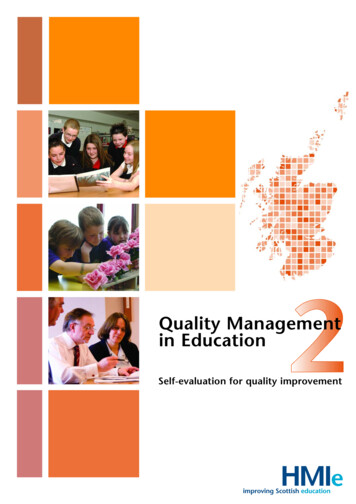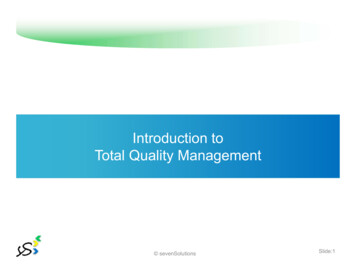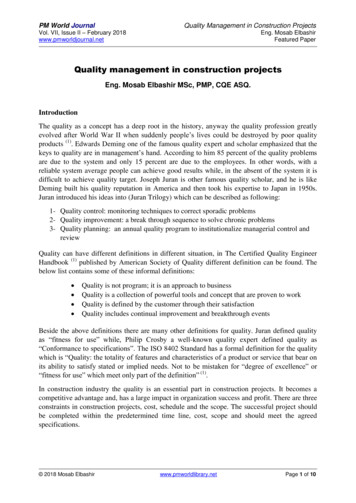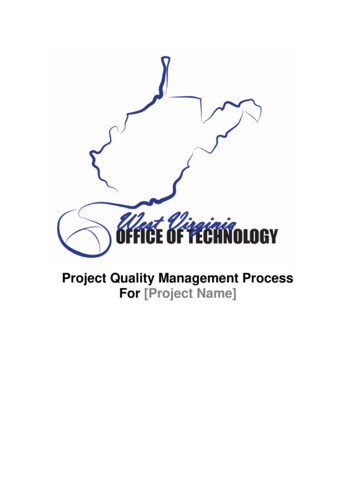
Transcription
Quality Managementin EducationSelf-evaluation for quality improvement
Quality Managementin EducationSelf-evaluation for quality improvementHM Inspectorate of Education 2006
Crown copyright 2006ISBN: 0 7053 1087 6HM Inspectorate of EducationDenholm HouseAlmondvale Business ParkAlmondvale WayLivingstonEH54 6GATel: 01506 600 200Fax: 01506 600 337E-mail: enquiries@hmie.gov.ukProduced for HMIE by Astron B45597 04/06Published by HMIE, April 2006This material may be copied without further permission by education authorities and educationinstitutions in Scotland for use in self-evaluation and planning.The report may be produced in part, except for commercial purposes, or in connection with aprospectus or advertisement, provided that the source and date therefore are stated.
ii n1Part 1Self-evaluation in the local authority context3Part 2The framework for self-evaluation explained7Part 3The six-point scale14Part 4Performance and quality indicators16Part 5Indicators, themes and illustrations22Part 6Using performance and quality indicatorsfor self-evaluation77Self-evaluation questions and sources of evidence86Part 7Appendix I The relationships betweenQuality Management in Education 2and other quality frameworks.104
QUALITY MANAGEMENT IN EDUCATION 2 – SELF-EVALUATION FOR QUALITY IMPROVEMENTForewordQuality Management in Education (QMIE), published by Her Majesty’s Inspectorate of Education(HMIE) in 2000, set out a framework for self-evaluation of the performance of educationauthorities in Scotland. It also provided the basis for the first cycle of external scrutiny byHMIE, namely the Inspection of the Education Functions of Local Authorities (INEA). All 32 Scottisheducation authorities have now been subject to external scrutiny through the first cycle ofINEA inspections.After a period of consultation involving education authority representatives, partner organisationsand other key stakeholders, a revised evaluative framework has been designed as a support packfor authorities. Quality Management in Education 2 (QMIE2), has been developed in partnershipwith key agencies and is designed to assist local authorities, together with their main stakeholders,to develop and implement a rigorous and systematic approach to the self-evaluation of theireducation functions. The emphasis within the publication is very clearly on the importance ofthe self-evaluation process and the role it plays in driving continuous improvement. Bothself-evaluation and inspection processes will be guided by the revised framework. The secondcycle of the statutory Inspections of the Education Functions of Local Authorities (INEA2)commenced in June 2005 with pilot inspections of two authorities. Inspection will take a moreproportionate approach. The scoping of inspections will be intelligence led and risk based.Existing sources of evidence such as HMIE reports on schools and community learning anddevelopment (CLD) provision, and reports by other agencies, such as Audit Scotland and theCare Commission, will inform the depth and breadth of inspections.We have come a long way since the inception of QMIE and INEA. The cyclical process ofself-evaluation is becoming increasingly well embedded across the Scottish educationallandscape, as a means of improving performance and raising attainment and achievement forall learners. Indeed, there is now a clear expectation by HMIE that self-evaluation will havebeen developed and established across all schools, establishments, services and authorities.A number of self-evaluation and external scrutiny models have been developed in recent years,including those which pertain to schools, community learning and development and childprotection. HMIE is acutely aware of the need for these to fit together in a coherent way.This document represents a unified framework which, through self-evaluation and externalscrutiny, evaluates performance against a common set of six high-level questions. Thesequestions will form the basis for all INEA2 inspections and, importantly, similar questions willform the basis for other inspections which relate to services for children and young people.They are: What key outcomes have we achieved? How well do we meet the needs of our stakeholders? How good is our delivery of education processes? How good is our management? How good is our leadership? What is our capacity for improvement?
iv vIn recent years, many initiatives have been undertaken to improve the quality of the serviceswe provide for children, young people, their families and adult learners. For Scotland’s Childrenbrought into sharp focus the need to put children and families at the centre of the publicservice network and, crucially, to provide better integration of services at the point of delivery.These principles must therefore apply also to the complementary processes of self-evaluationand external scrutiny. It is against this backdrop that the HMIE Services for Children Unitembarked upon a consultation exercise in October 2005 on A Common Approach to InspectingServices for Children and Young People, which proposes that a coherent, intelligence-led systemfor inspection of services for children and young people should be in place by 2008.The development of this QMIE2 support pack and of the associated INEA2 arrangements hasbeen guided by the need for a coherent approach to self-evaluation and inspection. It is alsorecognised that an increasing number of education authorities and, specifically, formerDirectors of Education who now have responsibility for a much wider range of services,including Social Services, Community Learning and Development, Sport, Leisure, Arts, Culture,Libraries, Museums and Housing Services, further underlining the need for an integratedapproach to monitoring and evaluation.One further and very important difference in the approach to self-evaluation through QMIE2, isthe much clearer focus on impact and outcomes. Self-evaluation should lead to the maintenanceof high standards, to further improvement in performance, to targeted action on areas needingto be improved and to continuous improvement in the pursuit of excellence. It is only byrigorous examination of impact, and of outcomes for children, young people, their families,adult learners and communities that the effectiveness of the education functions of councilscan be thoroughly and comprehensively evaluated.I commend this support pack to all authorities and their key partners in their pursuit ofcontinuous improvement through the process of self-evaluation.GRAHAM DONALDSONHM Senior Chief Inspector
QUALITY MANAGEMENT IN EDUCATION 2 – SELF-EVALUATION FOR QUALITY IMPROVEMENTAcknowledgementsThis support pack has been the product of consultation and partnership working involving awide range of organisations and individuals.The development of the document was undertaken through a consultation group whichincluded senior staff in Perth and Kinross, East Ayrshire, South Ayrshire, East Dunbartonshireand North Ayrshire Councils as well as representatives from Audit Scotland and NHS Scotland.Particular thanks are due to Ian McMurdo and Stewart Jardine who acted as consultants to theproject. Production of the pack was assisted further by feedback from a number of educationauthority staff and partner agencies. Thanks are due to colleagues who gave of their time inreading and responding to successive drafts of this document.The compilation of material for this document involved the identification of good practice withinexisting systems of monitoring and evaluation, including those in other public authorities andin the private and commercial sector. In this context, the work of the European Foundation forQuality Management (EFQM), Charter Mark and Investors in People (IiP) is acknowledged.
vi 1IntroductionThis publication has been designed to assist local authorities, together with their partner agencies,in developing and implementing a systematic approach to the self-evaluation of their educationfunctions. The publication provides practical assistance and advice on the process of self-evaluationat both strategic and operational levels. It focuses on the role of self-evaluation in developing acouncil’s capacity to drive continuous improvement and, most importantly, to secure anddemonstrate measurable improvement in the quality of learners’ educational experience. Theclear focus is on impact and outcomes.The self-evaluation support materials are also provided as an online resource. This will assistauthorities in amending or augmenting the materials to suit local needs, priorities andcircumstances. Authorities’ approaches to self-evaluation will build on existing good practice.The publication also includes the performance and quality indicators, measures and themes whichwill provide the basis for external inspection of the education functions of councils in this secondcycle of statutory inspections. Each authority will be able, through its own self-evaluationarrangements, to gather management information and evidence that enable it to judge theeffectiveness of its performance against six high-level questions, which will also form the basisfor inspections of the education functions of councils by HMIE. These are: What key outcomes have we achieved? How well do we meet the needs of our stakeholders? How good is our delivery of education processes? How good is our management? How good is our leadership? What is our capacity for improvement?Each of these high-level questions can be answered by evaluating the quality of educationacross ten Key Areas. At the centre of this framework are key performance outcomes and theimpact provision is having on service users, the community and staff. Inputs, such as leadershipand management, support the effectiveness of education processes and together help us toarrive at an overall evaluation of the council’s capacity for improvement. The framework issummarised in figure one on the next page.This guide aims to provide support for authorities in carrying out the process of self-evaluationthrough which they can: achieve the best outcomes for all learners; take action to sustain quality, improve services and achieve excellence; meet the responsibilities set out in the relevant legislation; and meet the requirements of Best Value and Efficient Government.
QUALITY MANAGEMENT IN EDUCATION 2 – SELF-EVALUATION FOR QUALITY IMPROVEMENTThe use of performance and quality indicators, for both self-evaluation and external inspection,promotes consistency. Although these two processes may differ in terms of purpose andaudience, their language and basis should be the same, enabling open and honest dialogueand consistency across different evaluations.city for imprr DeliveryofeducationesgoImourershiManand agemsu enof s ppor ttaff tyPolic entlopmdeve ndaingplannisadrsp?isodlesect on s e r vic e udgoipshreadLeparmanag e m e uImpact on thecWhat key ounityImmumoes havemwtcostaffonctpachieved?eaHowHow well dothe needs otefoemueholders?takrsweprocessess?seHowFIGURE 1 – THE OVERARCHING QMIE2 FRAMEWORKHowgoo
2 3Part 1 - Self-Evaluation in thelocal authority contextThe Standards in Scotland’s Schools Etc. Act 2000 provides a framework for improvementplanning that requires education authorities to set out and report on improvement objectivesrelated to national priorities and associated measures of performance. Continuous improvementin education services is central to the work of education authorities. There is a clear expectationby Scottish Ministers that national priorities will be addressed through agreed local educationimprovement objectives and related targets. To achieve these goals, it is essential for authorities,community services and establishments to work together to achieve these objectives and to raisestandards of attainment and achievement within an innovative culture of support and challenge.The process of self-evaluation should, as a matter of course, generate key management informationwhich results in an evaluation of overall quality and improvement. This evaluation can then beused to create a set of agreed, targeted action points which, in turn, drive further improvement.The process of self-evaluation is central to the maintenance of quality and the pursuit ofexcellence. It has become firmly established as the basis on which improvement planning andpublic reporting on standards and quality are founded. Self-evaluation is complementary toexternal inspection. Indeed the latter now builds on the results and evidence of self-evaluationacross the organisation. Self-evaluation, to be fully effective, is not designed to be a single orperiodic event, but rather is an ongoing process which permeates the culture of the council asit strives to maintain and enhance the quality of provision. It is a well-focused means to an endrather than an end in itself.The concept of self-evaluation is now well embedded across the Scottish educational landscape.In the best examples, it leads to the identification of main strengths and areas in whichperformance needs to be improved in the pursuit of excellence. The evaluations derived throughthe self-evaluation process should enable the authority to establish how it is performing againstits education improvement objectives, and to plan the next steps in development, in order tomaintain quality, secure continuous improvement and aspire to excellence.There are four main sources of evidence, from which evaluations can be made. These are: performance data; relevant documentation; stakeholders’ views and feedback; and direct observation of practice.These sources of evidence are complementary. No single source can meaningfully providesufficient evidence on its own to enable a reliable or robust evaluation to be made.The process also involves key stakeholders in full and meaningful discussion of the issues.1
QUALITY MANAGEMENT IN EDUCATION 2 – SELF-EVALUATION FOR QUALITY IMPROVEMENTEach authority aims to develop a clear picture of its main stakeholders and a protocol forengaging them in ongoing, focused discussion regarding its performance in key areas.Evidence shows that there is a strong link between effective leadership and management,robust self-evaluation, and development of the capacity for further improvement. To beeffective, self-evaluation will: be embedded in the culture of the organisation; be rigorous, comprehensive, systematic and transparent; be focused on identifying strengths and weaknesses or areas for improvement; be based on a wide range of evidence; involve a wide range of stakeholders; lead to targeted action and improvement; be recorded and reported; and be a continuous, systematic process as opposed to an event.QMIE, which is now being replaced by QMIE2, has become widely accepted by Scottishcouncils as a manageable self-evaluation framework. It relates closely to the wide range offunctions undertaken and services provided by authorities.Self-evaluation, inspection and Best ValueThe principles of Best Value and a commitment to delivering better public services year on yearare now embedded securely within the arrangements for local government in Scotland. TheLocal Government in Scotland Act 2003 provides the statutory framework for Best Value andoutlines the duties that are placed on local authorities to secure continuous improvement inthe performance of their functions. In delivering better public services year on year, localauthorities are expected to demonstrate: accountability; transparency; continuous improvement; and ownership.Scottish Ministers have set out a vision of how Best Value should contribute to the corporategoals of local authorities. There is a clear commitment to the highest standards of publicprobity and responsiveness to the needs of customers, employees and all other stakeholders. Inthe case of the education and CLD functions of authorities, this responsiveness clearly extendsto children, to all other learners and participants and to parents and families. The importanceof consultation arrangements, which are open, fair and inclusive, cannot be overstated.
4 51The core Best Value characteristics are now well recognised: commitment and leadership; responsiveness and consultation; sound governance at a strategic, financial and operational level; sound management of resources; use of review and options appraisal; competitiveness, trading and the discharge of authority functions; sustainable development; equal opportunities arrangements; joint working; and accountability.Authorities are expected to operate a framework for planning and budgeting that takes accountof national and local priorities and includes detailed and realistic plans linked to available resources.This means making the best use of all public resources including employees, contractualagreements, electronic communications, management information systems, land and propertyservices and sound financial systems. Effective performance management systems, whichincorporate the use of external comparisons and benchmarking, play a critical role inmaximising the use of public resources.Best Value also demands a comprehensive approach to service review that is rigorous and robust.It assumes that all services will be subjected routinely to rigorous scrutiny and competition. Inthe education and CLD services, such benefits would, in addition to maximising the effectivenessand efficiency of resource usage, extend to the achievement of continuous improvement in thequality of teaching and learning and to improving achievement, attainment and other relevantoutcome measures for children and adult learners.Services should be reviewed by using the process of the 4 Cs: Challenge Consult Compare Compete.Each council’s approach to Best Value should make a telling contribution to sustainabledevelopment in its widest sense, in terms of the social, economic and environmental impact ofactivities. Essentially, the pursuance of Best Value should lead to the development of a culturewhich encourages rigorous self-evaluation leading to improving services, and to equality ofopportunity through joint/partnership working and corporate service delivery.
QUALITY MANAGEMENT IN EDUCATION 2 – SELF-EVALUATION FOR QUALITY IMPROVEMENTFor some time now, authorities have been required to have a Performance Management andPlanning (PMP) framework which includes Public Performance Reporting (PPR) to account forperformance to stakeholders, and to increase public accountability.The framework of this publication and the indicators themselves deliberately and explicitlyreflect the principles, expectations and processes of Best Value. The concept of Best Value isbased on the principles of self-evaluation. This publication provides a Best Value self-evaluationstructure for education authorities. The Scottish Executive Best Value Task Group advised thatself-evaluation should be backed up by external scrutiny. It is against this backdrop that authoritiesshould view the process of external inspection of their education functions under the Standardsin Scotland’s Schools Etc. Act 2000 as the formal moderation of their own self-evaluation andthe major contribution to Best Value external scrutiny.The Accounts Commission for Scotland also has a statutory responsibility to secure the audit oflocal authorities and to achieve the highest standards of financial stewardship and the efficientand effective use of their resources within a Best Value context. The external auditor, onceappointed by the Commission, also has separate statutory responsibilities. Their audit frameworkis based closely on the PMP framework set out by the Best Value Task Group. The PMP auditincludes scrutiny of the council’s Best Value service reviews and its approach to PPR. HMIE andAudit Scotland (on behalf of the Accounts Commission) have designed and developed apartnership approach to scrutiny, based on the use of the evaluative framework. An inspectionof the education functions of councils will cover the requirements of education legislation andthe Accounts Commission’s statutory external scrutiny of PMP and PPR. Any additional workcarried out by the external auditor will feed into the inspection and PMP scrutiny model.In summary, there will continue to be a comprehensive and increasingly unified structure forself-evaluation and external scrutiny of the education functions of councils.
6 7Part 2 - The framework forself-evaluation explainedStructureThe framework for self-evaluation described in this section (and summarised in Figure 2 onpage 13) provides a systematic approach for councils to use for self-evaluation. The frameworkdoes not assume a particular organisational structure within the council. It can be appliedwhether responsibility for all education functions is located within a single department or isdistributed across a number of different council departments.The framework has been developed in accordance with the principles of the Excellence Modelof the EFQM and can be used in conjunction with other quality models such as IiP, CharterMark and ISO 9000. See Appendix I. Evidence produced through the use of other models cancontribute to overall evaluations.The framework is based on six high-level questions which can be answered by evaluating thequality of education systematically across ten Key Areas. What key outcomes have we achieved?Key Area 1.Key performance outcomes How well do we meet the needs of our stakeholders?Key Area 2.Impact on service usersKey Area 3.Impact on staffKey Area 4.Impact on the community How good is our delivery of education processes?Key Area 5.Delivery of education processes How good is our management?Key Area 6.Policy development and planningKey Area 7.Management and support of staffKey Area 8.Partnerships and resources How good is our leadership?Key Area 9.Leadership What is our capacity for improvement?Key Area 10.Capacity for improvementThe inputs and processes outlined in Key Areas 5-9 contribute to the outcomes and impactidentified in Key Areas 1-4.Key Areas 1-9 contain indicators and measures, each with themes which focus on specificaspects of the service being evaluated.2
QUALITY MANAGEMENT IN EDUCATION 2 – SELF-EVALUATION FOR QUALITY IMPROVEMENTKey Area 10 provides guidance which can be used to evaluate the degree of confidencereached by those carrying out the evaluation that the council has the capacity to continue toimprove. This evaluation will take into account the evaluations of other Key Areas, its trackrecord in improvements to date and significant aspects of its internal and external contexts.Using the framework in self-evaluationCouncils can use the framework to provide a systematic structure for self-evaluation.They can also use the framework as a diagnostic tool. By looking first at the outcomes andimpact of the education they provide (Key Areas 1-4), they can identify key issues for furtherexploration, observation and analysis using the tools provided within Key Areas 5-9.Finally, councils are encouraged to arrive at an evaluation of their overall capacity for improvement,using the guidance in Key Area 10.Using the framework in inspectionWhen engaging in inspection and reporting activities, HMIE will focus on specific Key Areasand indicators selected from the overall framework. Some of these Key Areas and indicatorsmay be used across all or most councils, while others may be used only in particular contextsand will depend on the scope of the inspection. The scope of each inspection will be set usingexisting evaluations and evidence to determine what is already known about the council. It willbuild on the self-evaluation already carried out by authorities. The inspection team will alwaysseek to answer the questions: What key outcomes has the service achieved? How well does it meet the needs of its stakeholders? How good is the leadership of the service? What is its capacity for improvement?Indicators drawn from the Key Areas relating to these questions will normally form the core ofthe set of indicators used during inspection. Beyond this, inspection activities might focus onspecific Key Areas and indicators selected from the rest of the framework. The selection willdepend on decisions taken during scoping activities and may be determined followingevaluation using the core set of indicators.HMIE will use the guidance in Key Area 10 to arrive at an evaluation of an individual council’soverall capacity for improvement.
8 92Answering the high-level questionsWhat key outcomes have we achieved?Key Area 1 focuses on the overall performance of a council in relation to its education functions.It provides a structure for councils to use when evaluating their success as organisations indelivering demonstrable outcomes as outlined in legislation and programmes for development.For example, these could include outcomes in delivering national priorities for education,improvements in attainment in 5-14 levels, Scottish Qualifications Authority (SQA) results or inachievement through The Duke of Edinburgh’s Award, programmes accredited through theAward Scheme Development and Accreditation Network (ASDAN) or Young Quality Scot Awards.Also important are the improvements made in relation to a council’s strategic priorities anddistinctive vision, values, aims and targets. These targets will include locally determined targetsfor social, education, health and care objectives in the context of children’s services and otherplans. Evidence would appear in reports on strategic and operational plans and as observableimprovements. In education, examples could include achievement of targets for participationin adult learning, cultural experiences, residential experiences and outdoor education.Evidence of demonstrable outcomes includes trends over time and other aggregated data whichprovide indications of the success of a council in improving the quality of the service it provides,both overall and in comparison with other councils.Key Area 1 also focuses on the extent to which councils fulfil their statutory duties, meet legislativerequirements, follow appropriate codes of practice and are financially secure. Examples includelegislation such as the Race Relations Amendment Act, the Disability Discrimination Act and theLocal Government Scotland Act. Fulfilling these duties and following relevant codes of practiceare key aspects of overall performance.How well do we meet the needs of our stakeholders?Key Areas 2, 3 and 4 focus on the impact on key groups of stakeholders of the council’s deliveryof education processes. In other words, these areas look at the benefits which stakeholdersderive from the council’s education services. Stakeholders include learners who are in directreceipt of the service together with those who support them and who also have a significantinterest in the delivery of high-quality services, for example, parents and families.Stakeholders also include the staff within the council who receive care, support, training andopportunities for involvement in decision-making and career development. Their motivationand satisfaction is of considerable importance if the council is to operate effectively. Evaluationswould draw upon the views of staff together with other information, such as rates of absenceor retention. The quality of the care and support given to staff can be evaluated by consideringevidence of teamworking, rates of involvement in professional development and achievementof qualifications and accreditation of the service as a whole by national schemes like IiP andScotland’s Health at Work (SHAW).
QUALITY MANAGEMENT IN EDUCATION 2 – SELF-EVALUATION FOR QUALITY IMPROVEMENTFinally, stakeholders include members of the community. These stakeholders include those fromthe immediate local community on whose lives and experiences the service has a demonstrableimpact. They also include the wider national and international community. The service maymake a significant contribution to thinking and practice within a particular area of work. Forexample, staff may be actively involved in working groups, lead national initiatives and shareinnovative practice with others. Evidence of the council’s impact beyond its immediate contextmay come from colleagues and peers, from published reports or from other media sources.When evaluating the impact of the council on the range of stakeholders, consideration shouldbe given to the overall balance of strengths and weaknesses. Those carrying out the evaluationneed to be alert to the possibility that in order to bring about improvements in one area ofimpact, the quality of service delivery in another area could diminish, with an overall detrimentaleffect on service to stakeholders.Evaluations of the quality of impact in these Key Areas will take into account direct observationand quantitative data together with evidence of stakeholders’ views, in order to arrive at overalljudgements of the impact of the service on its key stakeholders. Where evidence from thesesources is conflicting or indicates significant weaknesses, evaluators should follow audit trails toidentify and address the possible causes, using indicators from other Key Areas in the qualityframework. The focus of Key Areas 2, 3 and 4 will be on evaluating the impact on specificgroups of learners and other stakeholders, and arriving at holistic evaluations of the overallimpact on their experiences.There may be apparent discrepancies between the evaluations given within Key Area 1 and thosegiven within Key Areas 2, 3 or 4. An improving authority may provide considerable evidence ofimpact on its stakeholders. Significant changes in measurable outcomes such as those includedin Key Area 1, however, may take longer to become appar
Part 4 Performance and quality indicators 16 Part 5 Indicators, themes and illustrations 22 Part 6 Using performance and quality indicators for self-evaluation 77 Part 7 Self-evaluation questions and sources of evidence 86 Appendix I The relationships between Quality Management in Education 2 and other quality frameworks. 104 ii_iii Contents











